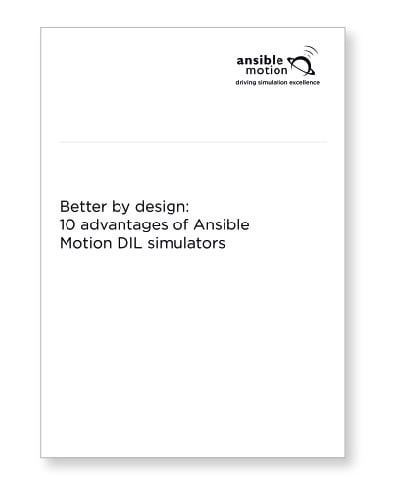 Elliot Dason-Barber, Ansible Motion's technical director, speaks with The Engineer about how Driver-in-the-Loop (DIL) simulators can give Formula 1 teams a competitive edge.
Elliot Dason-Barber, Ansible Motion's technical director, speaks with The Engineer about how Driver-in-the-Loop (DIL) simulators can give Formula 1 teams a competitive edge.
This detailed Q&A is included in a newly published special supplement of The Engineer, titled F1@75, which celebrates the 75th anniversary of motorsport’s flagship competition series and how it has driven innovation for three quarters of a century.
See the link below for details about how to access the complete digital and print versions. Here are a few excerpts from the Q&A:
1. Why are Driver-in-the-Loop simulators used by Formula 1 teams?
. . . [more] . . . With heavily restricted track testing and increasingly complex cars, DIL simulators have become racing programme cornerstones that are essential for staying competitive in today’s F1 landscape, since they provide F1 teams with controlled, repeatable virtual testing environments that mirror real racing scenarios in order to assess new aerodynamic packages, optimise vehicle setups and evaluate race strategies – all in advance of and in parallel with real cars turning wheels on track.
Having been directly involved in establishing several DIL systems within F1, I’ve seen first-hand how DIL simulator fidelity and correlation – particularly in vehicle dynamics, ride, tyre modelling and aerodynamic mapping – can directly translate into a competitive advantage.
. . . [more] . . .

2. Can you explain what exactly can be simulated using a DIL simulator?
With the latest engineering-class DIL simulators – particularly Ansible Motion’s Delta S3 – it’s possible to simulate almost every performance-critical element of a Formula 1 car, including purely conceptual car tuning setups and event scenarios that would not be possible to explore on with physical vehicles on track.
Beyond raw data generation – which is significant – properly set up DIL simulator labs serve as central hubs for collaborations between drivers and teams, ensuring that simulation models are calibrated not only to physical data, but also – and very importantly – to driver perceptions and feedback.
This driver-engineer-team communication creates an iterative loop that helps guide the fine-tuning of control systems, evaluation of balance and drivability changes, and confidence-building for setup maps ahead of race weekends.
. . . [more] . . .
3. How important is it that data produced by a DIL simulator correlates with data generated on-track?
Correlation is the critical link that gives simulators any sort of real-world relevance. In Formula 1, if the data generated with a DIL simulator doesn’t correlate closely with what happens on track, then the value of the (simulation) tool is massively compromised. Teams need to be confident that what the driver is feeling and what the engineers are interpreting in the DIL simulator lab reflects on-track reality – otherwise, decisions based on that data can lead someone down the wrong path.
. . . [more] . . .

4. Race strategy can be the difference between winning and losing – how do simulators help in this regard?
It’s difficult to comment on this, since F1 race strategy development in a simulator lab is highly dependent on the specific nature of the current powertrain units and other regulatory issues – both of which have changed dramatically in the last few years.
. . . [more] . . .
One advantage is that teams can replay the same scenarios again and again, and/or strategically focus on specific track segments that offer lap time gains – thus removing guesswork. Of strategic importance also is the fact that DIL simulation allows teams to test various test race strategies without consuming physical resources – equipment, fuel, tyres and so on – thus reducing their carbon footprints.
5. Do simulators give F1 engineers greater freedom to explore new ideas in a way that on-track testing does not?
Yes, absolutely, and that’s one of DIL simulation’s biggest advantages.
. . . [more] . . .
This freedom accelerates learning, supports decision-making, and promotes confident, data-backed tuning and development decisions. Some of the best, competitive-advantage ideas in F1 in recent years have come from DIL simulator sessions – radical departures from the norm that teams wouldn’t have dared tackle with on-track testing alone.
It’s the ability of DIL simulation to make changes in seconds – rather than hours – that encourages engineering creativity.
. . . [more] . . .
The full F1@75 special supplement can be accessed here in digital and print format.
It’s definitely worth a look, as it explores the technologies that have shaped the past, present and future of Formula 1, and examines the way in which engineering innovations have gone well beyond the race track.
In addition to the expanded Q&A above, you’ll find exclusive interviews with Formula 1 engineers and drivers, past and present; archive content; in-depth features exploring historical and current engineering innovations; high-level opinions from some of motorsport’s most influential figures; and key insights from some of the competition’s leading technology suppliers. We’re honoured that The Engineer asked us to lend a voice.




